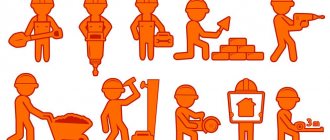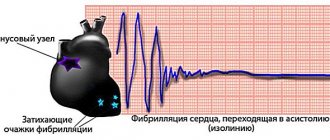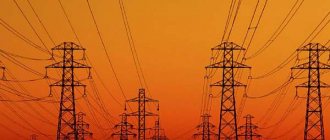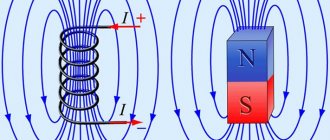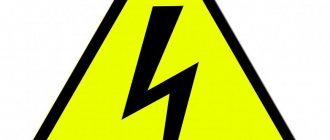When constructing buildings near the location of a high-voltage power line, a safe distance from the power line to a residential building must be maintained in accordance with SanPiN and SNiP standards. Limits are set by building standards and enforced by health inspectors. Fire safety rules are of no small importance for the distance between a residential building and power lines.
Electricity supply to cities
Types of power lines by voltage
All electrical installations and power lines have an electromagnetic impact on the environment. The main impact parameter is the electric field strength, which shows the level of force around the wires in the power line area. Due to electromagnetic radiation, lines of force arise in the space around power lines, which, when crossing any conducting medium, can induce an EMF in it. As a result, an unusual potential appears on any object, and in the presence of a closed circuit, electric current will flow.
However, the electromagnetic field strength is not uniform in space - the intensity decreases as one moves away from the power line. In addition, the gradation of harmful effects largely depends on the rating of the transmission line.
Therefore, all power lines are divided into the following categories:
- Low voltage – supply voltage in which is up to 1 kV;
- Medium level – for lines from 1 to 35 kV;
- High voltage – ratings for 110, 154, 220 kV;
- Ultra-high – for ratings from 330 to 500 kV;
- Ultra-high – power lines with voltages of 750 and 1150 kV.
It should be noted that the effect of electromagnetic waves depends not only on the voltage level, but also on the strength of the electric current flowing through the wires. Therefore, the generally accepted standard establishes the optimal distance to live parts, which will be safe [ ].
The Supreme Court explained when a house can be located in the power transmission line security zone
Ilya Kurenkov* had a house in the Krasnoarmeysky district of the Krasnodar Territory, built back in 1959. In 2009–2010, the man received permission for reconstruction and in 8 years increased the living area by 100 square meters. m. Before commissioning, the district administration recommended contacting Kubanenergo PJSC. But it refused to approve the reconstruction because the house is located in the protection zone of the power line.
There was a security zone a long time ago, but not in the Unified State Register of Real Estate
After this, the administration issued a notice that the rebuilt housing did not comply with urban planning legislation. It turned out that the power line next to the house was put into operation back in 1976. True, the decision to enter the boundaries of the security zone into the State Real Estate Cadastre was made only in 2012. That is, after Kurenkov was allowed to rebuild the house.
- Kurenkov's house was built in 1959;
- in 1976, a power line was put into operation next to this house;
- in 2009–2010, Kurenkov received permission for reconstruction and began to expand the house;
- in 2012, information about the boundaries of the power transmission line protection zone was entered into the state real estate cadastre.
The administration explained to the owner that they could try to legalize the reconstruction through the court.
Kurenkov filed a claim for recognition of ownership of the converted house. After all, information about the security zone appeared in the Unified State Register of Real Estate after the start of reconstruction. According to his version, the renovated house could not get into the security zone in any case, since new superstructures appeared on the side opposite the power line. The Krasnoarmeysky District Court agreed with this and granted the claim (case No. 2-675/2019).
But the Krasnodar Regional Court did not support this position. In protected zones of electrical networks, it is impossible to build or reconstruct any buildings without the written consent of the organization that manages these networks, the appeal recalled. And the power line also threatens those who live in such a house, the regional court explained and refused to recognize Kurenkov’s ownership of his new home [the appeal ruling dated August 1, 2022 was not published on the court’s website - approx. ed.]. The Fourth Court of Cassation upheld this decision. Then Kurenkov appealed to the Supreme Court.
More serious reasons are needed for demolition
In the Supreme Court, the case came to the “troika” chaired by Andrei Ryzhenkov (No. 18-KG21-5-K4). The judges paid attention to the chronology of the case. They noted that Kurenkov was not notified of restrictions on the use of land next to power lines. The appeal and cassation formally referred to the fact that the house is located in a security zone and did not explain what the threat was to people’s lives and health, the Supreme Court explained. And they have not established a cause-and-effect relationship between such a threat and the reconstruction of the house.
There is no evidence in the case that the location of the house could interfere with the operation of power lines, threaten the life and health of citizens, or lead to other negative consequences, the Supreme Court emphasized.
The regional court will have to pay attention to this when reconsidering the case (No. 33-18965/2021).
An old and common problem
Not only homeowners, but also owners of large warehouses, industrial and retail facilities often find themselves in such situations, says Vitaly Mozharovsky, head of the real estate and construction practice at Bryan Cave Leighton Paisner (Russia) LLP Bryan Cave Leighton Paisner (Russia) LLP Federal rating. group Antimonopoly law (including disputes) group Arbitration proceedings (medium and small disputes - mid market) group Foreign trade activities/Customs law and currency regulation group PPP/Infrastructure projects group Land law/Commercial real estate/Construction group Intellectual property (Protection of rights and litigation) group Intellectual property (Consulting) group International arbitration group Tax consulting and disputes (Tax disputes) TMT group (telecommunications, media and technology) group Transport law group Labor and migration law (including disputes) group Digital economy group Bankruptcy (including disputes) (high market) group Compliance group Corporate law/Mergers and acquisitions (high market) group International litigation group Tax consulting and disputes (Tax consulting) group Natural resources/Energy group Family and inheritance law group Criminal law group Pharmaceuticals and healthcare group Financial/Banking law group Private capital 2nd place By revenue 2nd place By revenue per lawyer (more than 30 lawyers) 5th place By number of lawyers Company profile. This is to blame not only for power lines, but also for numerous gas and oil pipelines and other dangerous objects that have security zones.
Until recently, there was no publicly available information about the security zones of hazardous facilities. Only their operators had it. Municipalities, which typically issued building permits, were also unaware of such zones. As a result, many objects were built in protected zones, but in good faith.
Vitaly Mozharovsky, head of real estate and construction practice Bryan Cave Leighton Paisner (Russia) LLP Bryan Cave Leighton Paisner (Russia) LLP Federal rating. group Antimonopoly law (including disputes) group Arbitration proceedings (medium and small disputes - mid market) group Foreign trade activities/Customs law and currency regulation group PPP/Infrastructure projects group Land law/Commercial real estate/Construction group Intellectual property (Protection of rights and litigation) group Intellectual property (Consulting) group International arbitration group Tax consulting and disputes (Tax disputes) TMT group (telecommunications, media and technology) group Transport law group Labor and migration law (including disputes) group Digital economy group Bankruptcy (including disputes) (high market) group Compliance group Corporate law/Mergers and acquisitions (high market) group International litigation group Tax consulting and disputes (Tax consulting) group Natural resources/Energy group Family and inheritance law group Criminal law group Pharmaceuticals and healthcare group Financial/Banking law group Private capital 2nd place by revenue 2nd place by revenue per lawyer (more than 30 lawyers) 5th place by number of lawyers Company profile
Now the Unified State Register of Real Estate includes a separate register of information about the boundaries of zones with special conditions for the use of the territory, adds Andrey Shubin, senior lawyer at Eversheds Sutherland Eversheds Sutherland Federal Rating. group Bankruptcy (including disputes) (mid market) group Foreign trade/Customs law and currency regulation group Intellectual property (Protection of rights and litigation) group Labor and migration law (including disputes) group Pharmaceuticals and healthcare group Environmental law group Corporate law/Mergers and takeovers (mid market) group Antitrust law (including disputes) group Land law/Commercial real estate/Construction group Tax consulting and disputes (Tax consulting) group Natural resources/Energy group TMT (telecommunications, media and technology) group Financial/Banking law group Arbitration legal proceedings (major disputes - high market) Company profile. With regard to power lines, it is expressly provided that the security zone is considered established from the date of entry into the cadastral register of information about its boundaries (clause 6 of the rules approved by Decree of the Government of the Russian Federation of February 24, 2009 No. 160). But it was not always so.
Security zones of old networks built during the Soviet period were not subject to cadastral registration. Restrictions in these zones are considered valid even now, even without cadastral registration. The courts believe that the restrictions are determined by the existence of the protected object, and not by the registration of the boundaries of the protected zone.
Andrey Shubin, senior lawyer at Eversheds Sutherland Eversheds Sutherland Federal rating. group Bankruptcy (including disputes) (mid market) group Foreign trade/Customs law and currency regulation group Intellectual property (Protection of rights and litigation) group Labor and migration law (including disputes) group Pharmaceuticals and healthcare group Environmental law group Corporate law/Mergers and takeovers (mid market) group Antitrust law (including disputes) group Land law/Commercial real estate/Construction group Tax consulting and disputes (Tax consulting) group Natural resources/Energy group TMT (telecommunications, media and technology) group Financial/Banking law group Arbitration litigation (major disputes - high market) Company profile
That is, in fact, the owner of the property is obliged to identify the linear object and its security zone independently. Information about this can be obtained from the master plan of a settlement, as well as from schemes of land use and development rules, says Shubin. But the information in them may vary, so it is quite difficult to accurately determine the boundaries of the security zones, the lawyer admits.
Home or compensation: The Supreme Court summarized the practice of demolishing objects near gas pipelines
In the last couple of years, the situation has begun to change for the better, adds Mozharovsky. Now, according to the Town Planning Code, public cadastral maps must reflect all zones with special conditions of use: protection zones for power lines and pipelines, sanitary protection zones, water protection zones, airfield zones, indentation zones and many others. If this task is successfully brought to its logical conclusion, there will be fewer conflict situations, the lawyer is sure. Municipal authorities and developers will be able to assess site restrictions and their risks in advance.
*Name and surname have been changed by the editors.
- Ekaterina Korobka
- Supreme Court of the Russian Federation
- Civil process
Safe distance from power lines to a residential building
Since it is not practical to reduce the transmitted voltage, a so-called sanitary zone is established around the lines, establishing a minimum distance from the area where the high-voltage line is located.
Thus, according to clause 4.1 of SanPiN 2971-84, the following parameters can be distinguished:
- For 330 kV lines - the distance must be at least 20 m to the nearest buildings;
- For power lines with a nominal value of 500 kV, it is necessary to maintain a distance of up to 30 m;
- For overhead lines with a voltage of 750 kV - at least 40 m;
- A distance of more than 55 m is allowed from the supports of 1150 kV overhead lines.
Figure 1: safe distance from power lines
The remaining electrical installations are relatively safe, since the design distance established by building regulations and the size of the security zone should be quite sufficient. Despite these standards, in some cities dangerous radiation also covers other high-voltage ratings; for example, in Moscow it is prohibited for buildings, gardens and garden plots to be closer than 20 m to a 110 kV overhead line.
However, scientific research abroad leads scientists to the opinion that the above values are insufficient for human safety, therefore, in a number of countries they are guided by the power of power lines, which takes into account not only the electrical, but also the magnetic component. In European countries, an expanded danger zone is applied to the distances to power transmission line wires, 4 to 10 times larger than in the post-Soviet space. This difference occurs due to the differentiation of the intensity of the impact of magnetic and electrical components on the human body.
Harm to human health
It should be noted that all electrical devices can have harmful magnetic and electrical effects on the human body, which can lead to both deterioration of health and exacerbation of chronic diseases. Some of the recent studies by Kosov A.A. and Barabanov A.A. , the role of electromagnetic fields and radiation in the human security system confirmed the direct dependence of most biochemical reactions on the level of externally induced voltage. In turn, powerful power lines have a much greater impact, so a standard for approaching the source has been established.
Figure 2: Electric field strength differences with distance
So, depending on the location, it is allowed:
- In populated areas, the voltage is no more than 5 kV/m;
- At intersections of highways and pedestrian roads up to 10 kV/m;
- Outside populated areas no more than 15 kV/m;
- In hard-to-reach places (mountains, forest belts, etc.) up to 20 kV/m.
If the above values are not observed during the construction or operation phase, power transmission lines may be relocated. In other cases, prolonged exposure to magnetic radiation of 0.5 kV/m is allowed.
However, there are a number of situations when, when performing technological processes or operations, a person may come close to or be directly in powerful electromagnetic fields. In this case, a restriction on the time spent near overhead line wires or supports is introduced for different voltage levels:
- At 5 kV/m – the duration of stay during the shift is not regulated;
- At 10 kV/m - the residence time should be no more than 3 hours;
- At 15 kV/m – no longer than 1.5 hours;
- At 20 kV/m – no more than 10 minutes;
- At 25 kV/m – no longer than 5 minutes.
If such standards are observed for staying near power lines, the human body recovers naturally within 24 hours, the chemical composition of the blood and the condition of the internal organs return to normal. If the duration of exposure to magnetic lines is longer, then shielding and special protective equipment are used.
Rice. 3. An example of human protection from electromagnetic radiation
Typical voltage value in residential areas
Within the areas of residential areas, power lines have a voltage of 6 to 10 kV, and there is no generation of radiation that exceeds the permissible values for people.
Power line supports and voltage indicators:
According to the provisions of SNiP, buildings for various purposes must be located 5 meters from the “red line”. Only a wire that is connected directly to the building can violate the safe distance.
The insulator securing the wire outside the building must be located on the wall of the building at a height of at least 2.75 meters. The entry of wires into the house should not be located above the entrance or near the rooms where people are most often. A safe place could be, for example, the wall of a utility room, pantry or hallway.
The sag of self-supporting insulated wires over a pedestrian path or walkway must be at least 3.5 meters, the sag between the supports of high-voltage lines - from 6 meters above the ground.
Pulling wires to connect a building from the opposite side should only be done using additional supports. In this case, the height to the insulators must be at least 6.2 meters, and the minimum horizontal interval from the overhead line with a voltage rating of 6 kV to high vegetation is 2 meters.
Impact on the environment and ecology
In addition to the impact on humans, harm from power lines also affects other living organisms. Thus, plants growing near power line supports and along the entire length of high-voltage wires begin to change. In some cases, the deviation of shoots and branches away from the line is clearly manifested, in others, branches atypical for a particular type occur, changes in the structure of the plant, etc. However, at the same time, some agricultural crops and fruit-bearing trees under the influence of power lines produce better yields and increase the formation of seeds.
Representatives of the animal world feel the impact and harm from passing power lines and try not to approach them at an unacceptable distance, sticking to pastures away from the lines. Electromagnetic radiation poses a particularly significant danger to artiodactyl fauna, since the hooves represent a layer of insulation that prevents the charge from flowing to the ground. Because of this, a significant potential can be induced in the animal’s body, which will be discharged at the first touch to the grass or tree leaves.
Rice. 4. Impact of power lines on artiodactyl animals
In relation to insects, a particularly strong reaction is observed between power lines and bees. Since in the case of the location of the hives directly below the line, the activity of individuals, honey collection and offspring are significantly reduced. In some cases, the death of queens that do not leave their habitat is observed.
The more expensive electronics are, the safer they are?
In theory, high-quality household appliances will be more harmless, since the larger and more “renowned” the manufacturer, the more he will care about his image and, accordingly, certify all his products as responsibly as possible. But this, of course, also affects the cost of the equipment.
However, it is worth considering that this only applies to new equipment that has not been subjected to physical impact, repairs, with proper operation, location, etc. If at least something has been disturbed, then the intensity of the radiation can change significantly.
Harm to technology and means of communication
Also, damage from power lines is observed at nearby electrical installations; overhead line devices and communication lines are especially susceptible to the influence. Obvious harm for them is expressed in the induction of excess potential at frequencies close to or equal to the frequency of signal transmission. What causes interference or distortion of transmitted data. For devices in a grounded metal casing, the damage to power lines will be insignificant, since the outer casing acts as a natural shield.
A separate issue is the damage caused to underground communications, in particular pipelines. In the case of close proximity of power lines, an EMF occurs on the conductive surface of the pipeline, causing metal removal and premature corrosion destruction. In addition, an underground electrical pipe can cause electric shock to a person. Therefore, they are also trying to secure them with the help of UZTs, which provide safe underground crossings or parallel laying along power lines.
Bottom line
Having studied the above material, we can summarize that the presence of a person near lines with voltages above 1 kV not only affects a person’s well-being, but can also cause significant harm to his health. Therefore, in case of forced stay near high-voltage power lines, a person must minimize his time in dangerous areas.
If the line is located in close proximity to your home and you are not sure of the safety of the proximity to the power line, then specialized measurements should be made. Which can be performed by organizations with the appropriate level of qualifications and equipment. They will check the compliance of the electromagnetic background in your home with sanitary standards.
Sources used:
- https://www.elibrary.ru/item.asp?id=35368561
- https://www.niehs.nih.gov/health/topics/agents/emf/
- https://publications.iarc.fr/98
Safety rules for exposure to electromagnetic radiation on the human body
The best protection against EM radiation is distance.
The radiation density decreases significantly with distance. Each source has a fairly limited radius of action of the fields, so proper planning of places for rest/leisure, work and sleep is already the key to your health, however, you should not forget that any de-energized source of EM fields ceases to be such.
Therefore, do not forget to turn off unused devices from the network, do not place powerful EMR sources near your head, monitor the condition of household appliances and read the instructions for the proper use of household appliances.




